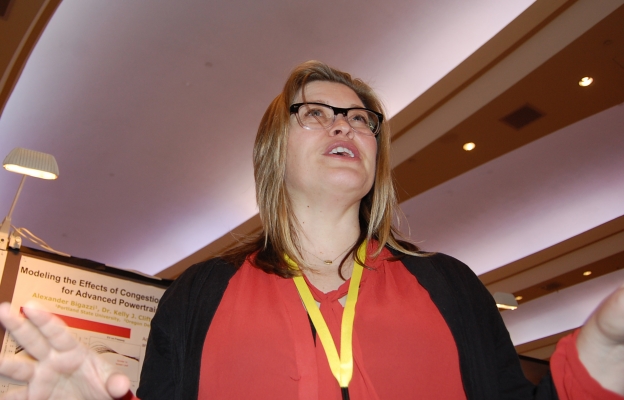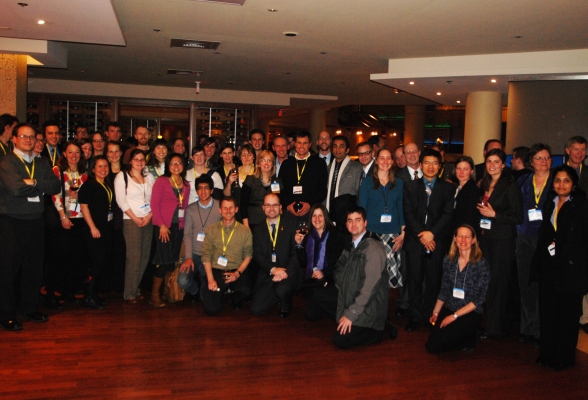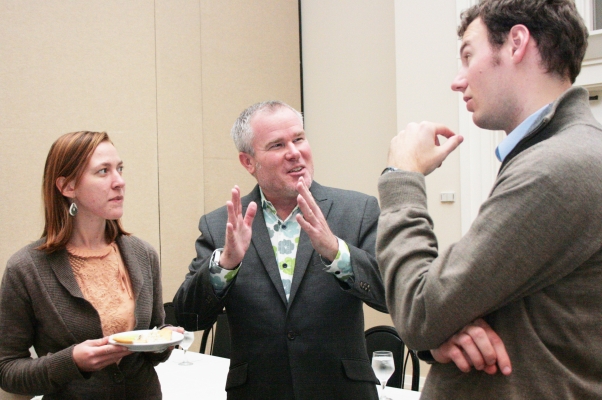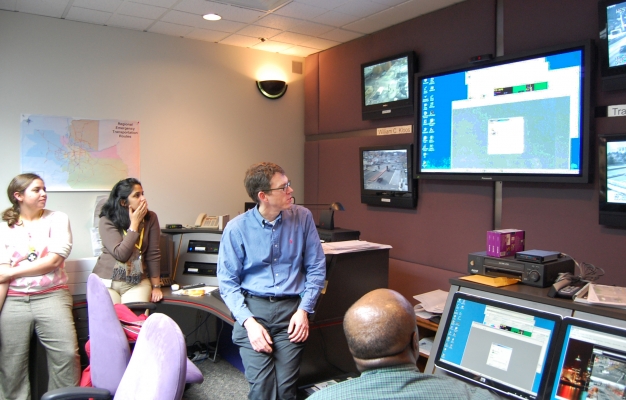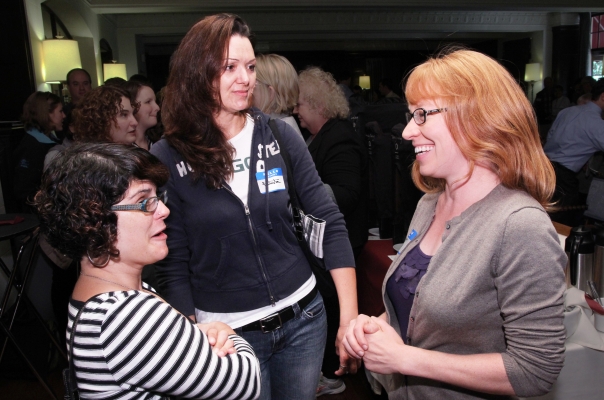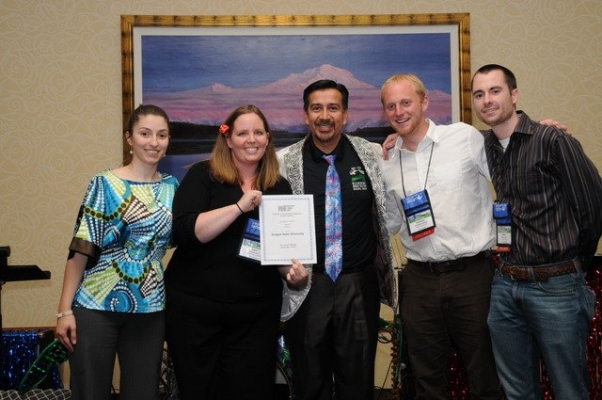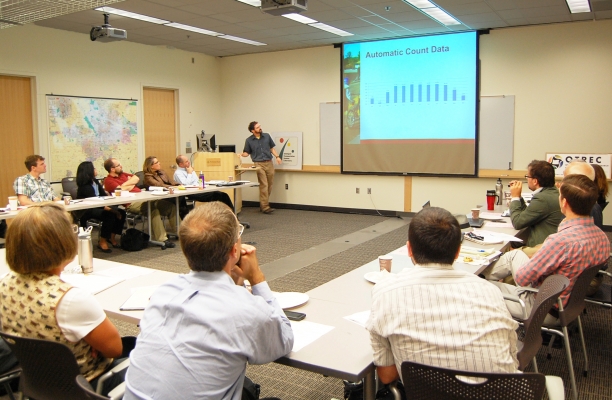Planners looking to develop an dense mix of urban land uses often face a dilemma: they’re using trip-generation models that undercount the very trips on bicycle and foot that the planners encourage while paving the way for more driving.
Portland State University Associate Professor Kelly Clifton dove into the topic Monday, presenting a paper at the Transportation Research Board annual meeting in Washington D.C. Kristina Currans of PSU, April Cutter of Metro, and Robert Schneider of the University of California Berkeley are coauthors.
Clifton and other panelists agreed that the Institute of Transportation Engineers’ trip generation rates don’t adequately reflect actual trips in an urban area with multiple land uses and transportation modes. They differed on the remedy, however.
Presenting another paper, Associate Professor Kevan Shafizadeh of California State University Sacramento, evaluated and tested several complex methods, finding that none truly suits smart-growth development projects. However, Shafizadeh and his team found that every method tested does a better job at predicting the number of trips generated than the ITE rates.
We need to predict trips better, Clifton said, but perhaps a simpler solution exists. She acknowledged Shafizadeh’s conclusions that each alternative also had deficiencies in certain applications, and suggested that the ITE rates could be tweaked instead of scrapped entirely.
“It’s a Band-Aid to temporarily adjust...
Read moreStudents and faculty researchers from OTREC universities will present 45 papers at the Transportation Research Board’s annual meeting Jan. 22 to 26 in Washington, D.C.
The papers, to be presented at 37 separate sessions and poster sessions, stem from transportation research at Portland State University, the University of Oregon and Oregon State University. The three universities will send 43 students to the conference.
Alex Bigazzi, a PSU engineering doctoral student, will present his work on topics including congestion and emissions at the conference. Some of that work stems from his master’s thesis, “Roadway Congestion Impacts on Emissions, Air Quality, and Exposure,” with adviser Miguel Figliozzi at PSU. The thesis won this year’s Milton Pikarsky Memorial Award, which will be presented Jan. 21 at the Council of University Transportation Centers awards banquet.
Bigazzi will present another paper, which he wrote with PSU’s Kelly Clifton and Brian Gregor of the Oregon Department of Transportation, that looks at fuel economy for alternative-fuel vehicles in congestion. Titled “Advanced Vehicle Fuel-Speed Curves for Regional Greenhouse Gas Scenario Analysis,” the paper helps Oregon DOT incorporate hybrid, electric and fuel-cell vehicles into its emissions planning model.
While traditional vehicles lose fuel efficiency during congested driving, advanced vehicles don’t suffer from the same effects, according to the paper. Some even do better in...
Read moreThe U.S. Department of Transportation awarded Portland State University $3.5 million for research and education on sustainable transportation topics, the department announced today. The Oregon Transportation Research and Education Consortium (OTREC), the university transportation center based at PSU, will administer the grant.
OTREC, a partnership between PSU, the University of Oregon and the Oregon Institute of Technology, will join with the University of Utah to carry out the grant. This award reaffirms OTREC’s evolution into one of the nation’s leading transportation livability research centers and provides the resources to address national problems strategically.
Research and educational programs under the grant will focus on the following topics:
- Improving health and safety for all users
- Increasing the efficiency and understanding of cycling, walking and transit
- Making the best use of data, performance measures and analytical tools
- Integrating multimodal transportation with land use
- Taking long-term action on transportation emissions and climate change.
PSU was one of 63 applicants for 22 grants. The grant competition challenged university transportation center leaders to demonstrate the ability and experience to produce the country’s best transportation research and educational programs. “In five years, OTREC has advanced the state of research on topics such as the connections between transportation...
Read moreThe Initiative for Bicycle and Pedestrian Innovation has received a gift to support an annual transportation lecture at Portland State University. The gift, which establishes the Ann Niles Transportation Lecture Endowment, was finalized last month.
Created by Philip Niles in memory of his late wife, Ann, the endowment will bring a speaker each year to address transportation and planning issues for students, faculty and the community. Ann Niles was a strong advocate for livable neighborhoods and served on many transportation-related boards and committees in Portland.
Ann Niles grew up in Grants Pass, Ore., and graduated from Reed College in Portland, where she met Philip. She earned a graduate degree in library science from the University of Minnesota and began her career at the Carleton College library.
Ann and Philip retired in 1999 and returned to Portland. Ann developed a second career in urban development and transportation and worked with the city of Portland and the Pearl District Neighborhood Association. She chaired the Pearl District Transportation Committee for eight years, promoting better sidewalks and crosswalks for pedestrians and better bicycle routes and parking throughout downtown Portland. Ann also represented the Pearl District on the Portland Streetcar Citizens Advisory Committee and the advisory committee for Portland’s transit mall revitalization.
Details on the lecture series,...
Read moreNothing signals the holiday season like a contentious multi-billion-dollar public works project. With that in mind, Portland State University's Students in Transportation Engineering and Planning sought to design and build an edible version of the Columbia River Crossing project. Teams of students built the bridge portion of the project using only edible elements, including graham crackers, licorice and gummy creatures.
The event, held Dec. 8, was the second annual competition for STEP. Last year, teams competed to build a gingerbread transit station.
Dan Marriott, a historic road preservation planner, believes that Oregon should be proud of its heritage of excellent historic and scenic routes crisscrossing the state.
Marriott presented this message, plus a broad overview of historic road preservation, during his lecture “Historic Roads: Inspiration and Conservation in the 21st Century” at the Downtown Athletic Club in Eugene on November 10th. His lecture highlighted his years of expertise as a planner and preservationist. Marriott is the founder of Paul Daniel Marriott + Associates, a planning office that specializes in analysis and preservation strategies for historic and scenic roads.
Marriott pointed specifically to the beauty of the Columbia River Highway, built from 1913 to 1922. The highway was called “America’s greatest scenic road” when it was built and attracted pleasure drivers from far away as New York. He praised the State of Oregon’s commitment to preserve the roadway and facilities along the route, acknowledging its past while understanding its present value.
Marriott also presented examples of other historic roads from around the United States. The lecture audience was led down such famous roads as Route 66, stretching from Chicago to Los Angeles, and the Colonial Parkway, connecting the colonial-era communities of Jamestown, Williamsburg, and Yorktown, Va. In each of these roads, as well as the others he presented, Marriott showed that preservation does not have to come at...
Read moreIn town to network and share research results, participants in the Region X Student Transportation Conference also saw the inner workings of the transportation system and even got to stop Portland traffic.
The ninth annual conference drew around 75 people to Portland November 18. The conference showcases student transportation research in Oregon, Washington, Idaho and Alaska and is entirely organized and run by students.
This year, the conference also featured breakout sessions and tours with working transportation professionals. Groups visited the Oregon Department of Transportation Region I incident management command center, dug into city of Portland traffic signal systems and operations, toured the city’s bicycle infrastructure and explored the mechanics of Portland’s drawbridges in detail with three bridge lifts.
Portland State University’s student group, Students in Transportation Engineering and Planning, or STEP, hosted the conference, which was sponsored by OTREC. The conference provides plenty of formal and informal opportunities for students working at different universities to inform each other, said Kristi Currans, an organizer with STEP.
“My favorite part is just having all the students get together and find out all the research everyone is doing,” Currans said. “Even within Portland State, if people are working for different professors, I might not know what they’re working on.”
The conference drew students from Portland State...
Read moreThe third Sustainable City Year partnership, this year with Springfield, Ore., is officially underway after a kickoff ceremony Sept. 28 at the University of Oregon. The experiential learning program, part of the OTREC-supported Sustainable Cities Initiative, focused on the cities of Gresham and Salem, respectively, in its first two years.
Each year, Sustainable City Year channels the resources of courses across disciplines to serve a single city for an entire academic year. Students gain invaluable experience working directly with city staffs on real-world projects. The cities gain the resources to take on needed projects that would never see the light of day without the program.
In Salem, the program encompassed 28 courses, 25 faculty members on two campuses, 10 disciplines and more than 500 students and 80,000 hours. The Springfield partnership is expected to involve more than 400 students and 20 faculty members. Projects will involve Springfield city staff from several departments and participation from the Springfield Utility Board, Willamalane Park and Recreation District, Metro Wastewater Management Commission, United Way, the ...
Read moreOregon State University’s student ITE chapter is the reigning Western District ITE chapter after taking the Student Chapter Award at the district’s annual meeting in Anchorage, Alaska. The award honors the outstanding chapter for the entire 13-state region, which encompasses 34 student chapters.
The award marks a quick turnaround for a chapter that was dormant a few years ago. Faculty adviser Karen Dixon restarted the chapter when she arrived at Oregon State in 2005. “Another professor, David Hurwitz, came from an active chapter and shared insights he had as a student,” Dixon said. “That helped give us that push.”
Applying for the honor requires a thorough accounting of all the chapter’s activities, Dixon said. “You have to document every tiny thing.”
And having a lot to document was one of the reasons Oregon State won the award, said student chapter President Lacy Brown. “We did a lot of activities out in the community,” Brown said. “A lot of outreach to other students on campus who weren’t necessarily in our chapter.”
The chapter brought in speakers from private consultants and public agencies, took field trips across the state and attended conferences in the Northwest and beyond, including the Transportation Research Board...
Read moreIn transportation funding decisions, you don’t count until you’re counted. That fact can lead to cyclists and pedestrians, often overlooked in traffic counts, getting less than their share of transportation money. OTREC hosted a conference Sept. 15 to address that problem.
“Without the data, you have an incomplete picture of how the (transportation) system is being used,” said OTREC researcher Chris Monsere, the conference organizer. “And it’s easier to make the case for resources if you know how the system is being used.”
The conference, called the “Bike and Pedestrian Program Information Exchange & Technology Transfer Summit Meeting,” brought together officials from local and state transportation agencies and consultants to share features of the best counting programs and technology. The forum helped bridge a gap between people who count motor vehicles and those who count bicycle and pedestrian traffic.
“We wanted to raise a little awareness of both sides of the equation,” Monsere said. “There are things both can learn from the other.” <All presentations available for download at the end of this article>
Nonmotorized counting programs often get large numbers of motivated people involved quickly and have a strong network for distributing results of counts. Motorized counts tend to be more systematic and uniform.
The motorized traffic counts have a jump on their non-motorized counterparts, Monsere said. That’s largely a result of...
Read more
